1lumen selects and reviews products personally. We may earn affiliate commissions through our links, which help support our testing.
Volterrex PL-48W-G1 LED Lantern review

Volterrex PL-48W-G1 LED Lantern specifications
| Brand & Model | Volterrex PL-48W-G1 LED Lantern |
|---|---|
| Flashlight category | Camping Lantern / Worklight |
| LED | Unknown SMD |
| Max. output | 4,000 Lumens |
| Max. beam distance | N/A |
| Max. beam intensity | N/A |
| Battery config. | Built-in li-ion battery pack |
| Onboard charging | 5.5 x 2.1 mm connector input |
| Main modes | 4 |
| Blinkies | Safety Flasher |
| Waterproof | IP54 |
| Review publication date | April 2024 |
Review intro:
I’ve been reviewing lighting devices for a while now, and thought I had a general understanding of the different brands out there…Emisar, Lumintop, Reylight, Acebeam, Volterrex. Volterrex? That’s a new one for me, and honestly I don’t know much about them, but after educating myself a bit, I found out that they’re actually a legit company in a very important corner of the market: Area lighting.
Volterrex is actually the dba (doing business as) of ISM Lighting. They’re a local company based in Rhode Island, often sold at Lowes Home Improvement. Browsing their catalog, their focus is tripod and mast-mounted balloon style lighting for construction sites and work areas. These balloon lights are basically inflatable diffusers with LED arrays inside that produce diffused light output. They have small ones and big ones ranging from 7800 Lumens up to 135,000 Lumens.
That’s a lot of light, and the biggest one is said to cover over 70,000 square feet of work space. That’s a lot. Their lineup also includes a lone lantern, known as the LED Pro Lantern. They’ve sent it to me for an honest review, which I will happily deliver. The lantern space is a somewhat crowded one, and it’s full of cheaper options with dubious output claims and sketchy durability. I’m a camping/outdoors junky and appreciate a nice lantern. This one claims 4000 Lumens and is a rugged tool ready to go to work. Let’s see how it does.
What’s in the package
The Volterrex lantern comes in a big box with tons of feature blurbs and graphics, as I expect from a retail-ready package. Inside, the lantern is well-protected in formed cardboard holders. Here’s what’s inside:
- Volterrex PL-48W-G1 lantern
- Instruction guide
- Carry bag
- Charging adapter
- Screw-in eyelet
- Screw-in mast mount
This is a ready to run kit, as expected. The battery was fully charged and ready to go to work! I also appreciate the mounting items they included, like the eyelet and the post mount for Volterrex’s tripod/mast. The bag is a nice addition as well. It’s high quality, durable nylon with a drawstring closure. It doesn’t seem cheap and should last a while.




Flashlight in use, Build Quality, and Warranty
The Volterrex lantern is a high power lighting device for lighting up large or small areas. It’s nicely portable for a large lantern, and occupies the same space as a traditional camping lantern. It’s almost the same size as my vintage Coleman 288. Since it runs on batteries and uses LEDs, it’s a lot more versatile and user-friendly than a propane or naphtha fueled lantern. No poisonous fumes, no open flames, no intense heat. Take it in your car, home, cabin, tent, enclosed workspace, you name it, without worrying about getting suffocated by fumes or setting stuff on fire. Plus instant startup or fiddling with matches or lighters. Gale force wind and/or pouring rain are no problem for this thing.
You get a lot of mounting options here. There’s the expected sturdy handle for hanging and carrying. It has stout detents at about every 20 degrees, so it can prop the lantern up to use the forward firing flashlights in the top. There’s also a very substantial brass threaded insert (no plastic here) on the bottom for threading in the equally substantial steel eyelet or the mast/tripod mount. The eyelet is thick zinc plated steel a full 8 mm thick. Overkill? Yep! The insert is not the typical ¼ -20 thread pitch most all tripods or tripod shoes have though, so you’ll need a different tripod mounting solution (or just buy the tripod/mast from Volterrex).
The base has 4 anti-skid rubber feet for stability on uneven surfaces, and also has an integrated hanger that folds out from the bottom for hanging. The top of the lantern houses 5 pebbled, triple LED TIR lenses that focus light forward/upwards so you can use it like a flashlight (more of a floodlight).
Operation is dead-simple and accomplished with two rotary switches on a font panel. In between the two switches is a 4-segment LED display for the battery state. The left knob has 4 positions and controls the lighting modes, the other is a potentiometer that controls the infinitely adjustable brightness and doubles as the on/off switch. It’s super easy to use, which is important here. All the controls are clearly and intuitively labeled and laid out. There’s a large rubber cover on the backside opposite the switches for the charging input and power bank output. The cover is super beefy, thick rubber and recesses deeply into the base so it creates a nice seal, but it’s a bit tough to seat. I think some silicone paste on the edges of the seal would help that.
Build quality? It’s freaking awesome and this thing is built like a tank. This is the sturdiest lantern I’ve encountered and I doubt anything short of falling 15 feet or an ax attack would knock this out. It’s made from mostly plastic, but it’s sturdy injection molded impact-resistant ABS with extra reinforcement where needed. The lighting unit sits on a large, heavy powder coated die-cast aluminum heatsink that the MCPCB elements mount to for heat management. The plastic molding is well done with no errant flashing or mold marks.
The lantern globe is made from polycarbonate or Lexan and would stand up to a great deal of abuse. It’s also frosted, so unlike a clear globe, scratches or damage won’t be as obvious or detrimental. A professional-grade tool carries a professional-grade price, and the Volterrex LED Lantern isn’t cheap at around $240 US, but that’s not a bad deal at all. Overall, this is a very well-built lantern and should withstand rough-and-tumble treatment from workers who aren’t always ‘nice’ to their equipment. It also sports a decent amount of ingress protection and Volterrex gives the lantern an IP54 rating, so it will be well protected from downpours and detritus intrusion.
For the warranty, Volterrex provides a 1 year warranty for the lantern and a 1 year warranty for the internal battery. That seems a bit sparse for a working light, but I’m sure Volterrex will gladly support any after sales issues.
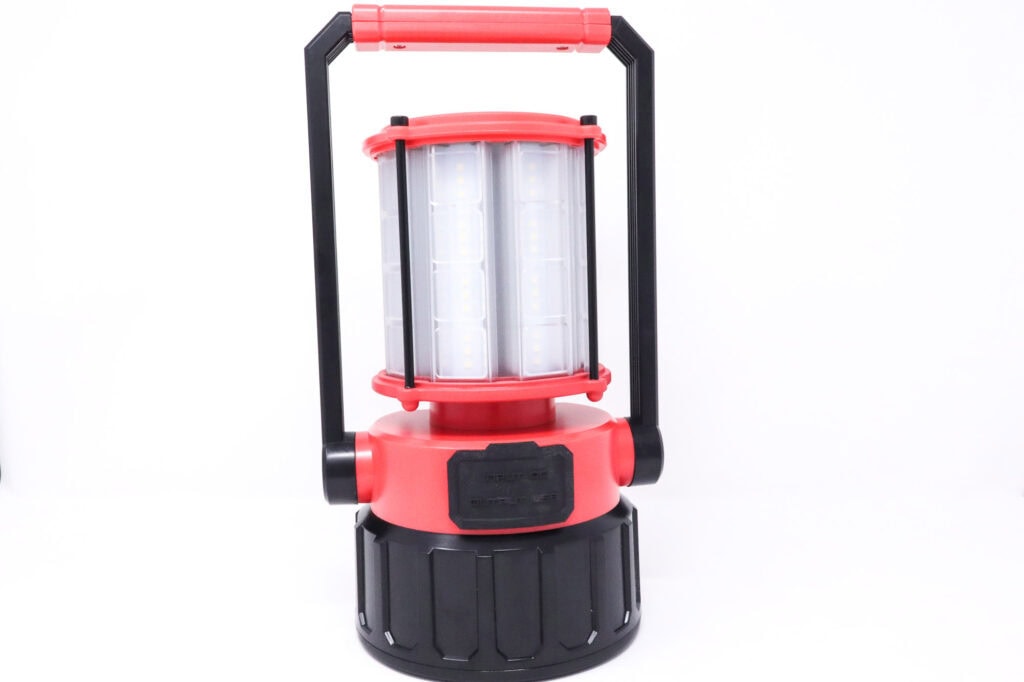







LED, Lens, Bezel, Beam, and Reflector
Volterrex doesn’t advertise the LEDs used here other than they’re Philips Lumileds. Philips has a pretty deep product lineup, but these look like 2835 CSP SMD LEDs mounted in groups of 4 for each MCPCB. There’s a total of 8 lens elements, each with 12 LEDs, for a total of 96 LEDs for the main light source. These sit radially to provide light in a 360 degree pattern, and they really provide a lot of evenly dispersed light.
Up top, there’s 5 pebbled TIR lenses with 3 similar (or appears to be) LEDs providing the top light source These are super-floody and provide a somewhat focused beam, but it doesn’t travel very far. Volterrex does state that the lantern light source is 5000K at min. 80 CRI, and while the top-mount LEDs aren’t called out for tint and CRI, when I measured them, they are a bit cooler, but still the 80+ CRI.
Overall, the beam and tint from this lantern is excellent. The main light mode (lantern) is diffused enough so it’s not blinding unless you’re staring at it. The top lighting mode is also extremely versatile, and offers more beam distance than the main light, but still has a lot of side illumination for area lighting when hanging upside down or when using the lantern on its side. It’s an excellent, well-rounded light source for indoor or outdoor lighting tasks.
Spectral measurements:
I used the Opple Lightmaster Pro to measure the flashlight at 1 meter from the sensor.
| Mode: | CCT: | CRI Ra: | duv |
|---|---|---|---|
| 360° 100% | 4866 K | 83.6 | 0.0016 |
| Front 100% | 5227 K | 84.1 | -0.0002 |



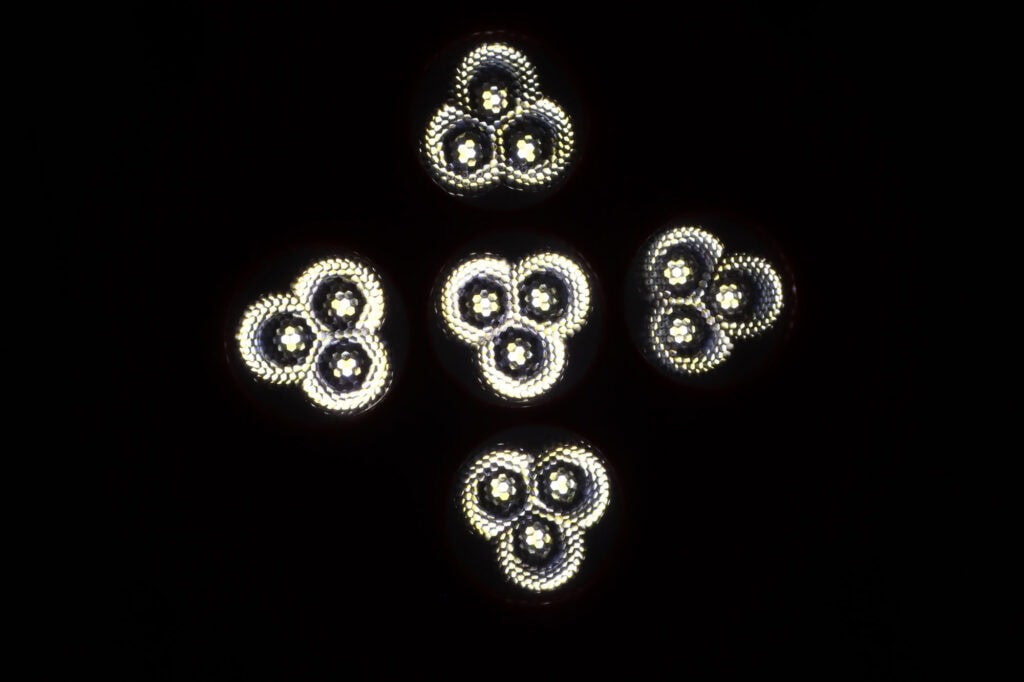


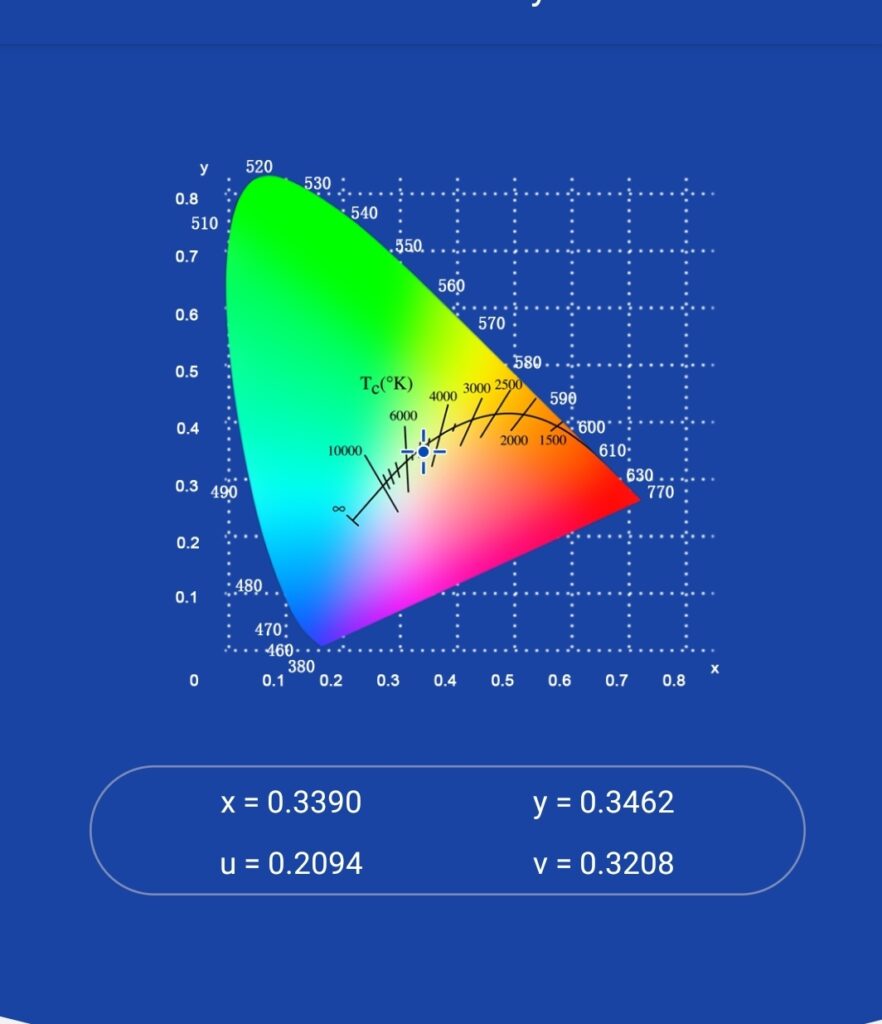
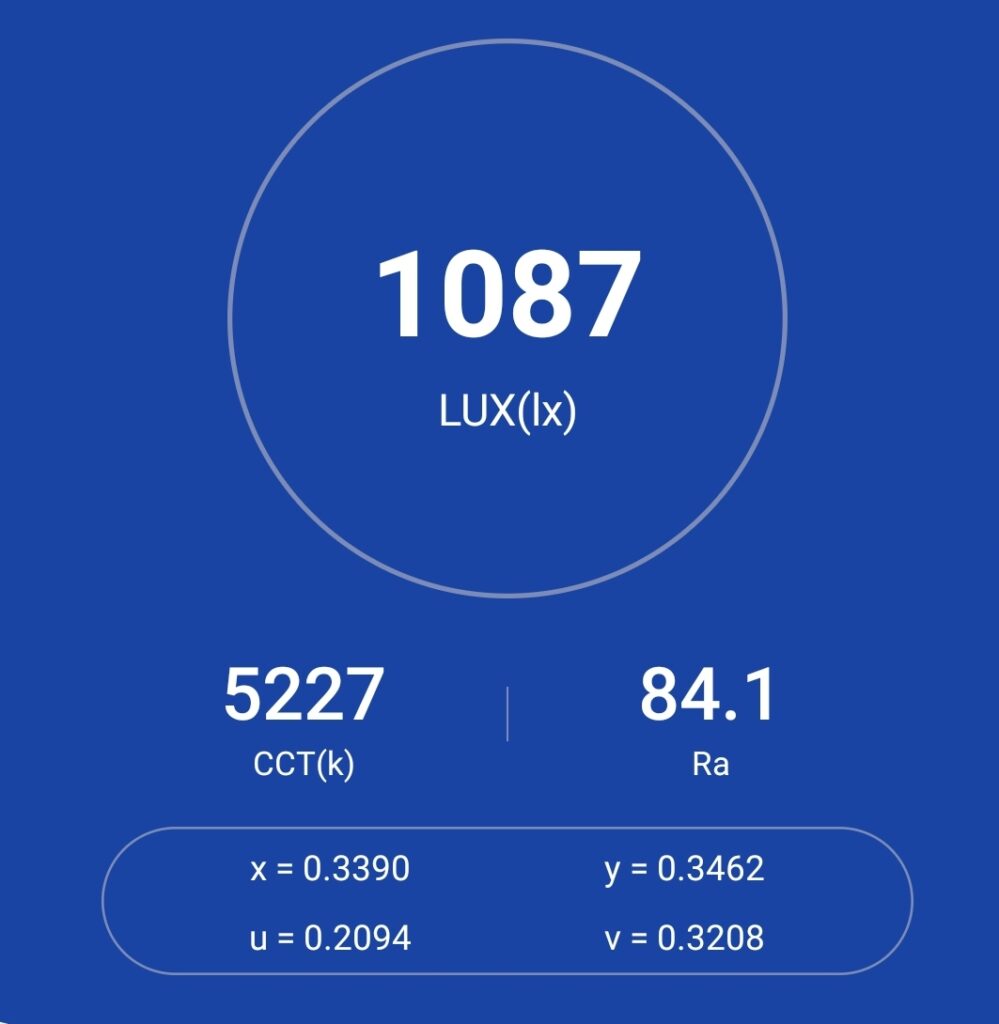
Dimensions and its competition
Dimensions:
| Volterrex Lantern | Millimeters | Inches |
|---|---|---|
| Height | 258 mm | 10.6 in |
| Height (with handle raised) | 317 mm | 12.5 in |
| Body diameter (widest point) | 168 mm | 6.6 in |
Dimensions are rounded to the nearest millimeter and the nearest tenth of an Inch.
Weight:
| Volterrex Lantern | Weight in grams | Weight in oz |
|---|---|---|
| With battery | 2279 g | 80.2 oz |
Weight is rounded to the nearest gram and tenth of an Oz.
Flashlight size comparison with its competition:
Group 1 left to right: Volterrex Lantern, Coleman 288
Group 2 left to right: FireflyLite NOV-Mu v2, Mateminco MT-911, Volterrex LED Pro Lantern, Fenix CL26R Pro
Group 3 left to right: Olight O’Lantern Classic Pro 2, Volterrex LED Pro Lantern, Olight O’Bulb



Volterrex Pro Lantern: User Interface and Driver
The driver is a mystery. The input from the battery is 4S, so there’s probably a buck driver providing constant current regulation to the LEDs. How they’re wired up is a mystery also, so there’s some electrical wizardry at work here.
The UI is dead simple, like it should be for a lantern, and it works with the two rotary switches. These control infinitely adjustable brightness for the 4 lighting modes. There’s a 360 degree mode, a 180 degree mode, and a front-firing top light mode with a safety flasher. The brightness is infinitely variable from 5% to 100%.
Available modes:
- 360°, 180°, and Top Light
Available blinky modes:
- Safety Flasher
From OFF:
- Turn dimmer switch clockwise: Turns on in Low (5% output)
From ON:
- Turn dimmer switch clockwise: Increases brightness
- Turn dimmer switch counterclockwise: Decreases brightness
- Turn dimmer switch fully counterclockwise: Turns off
- Turn lighting mode selector clockwise: Changes lighting modes 360-180-Front-Front warning flasher
- Turn lighting mode selector counterclockwise: Changes lighting modes (reverse order)
Mode memory:
- None
Shortcuts:
- None
Low voltage warning/protection:
- The four LED indicators show battery level in 25% steps. The output drops very low for LVP, and the LED indicator will flash on the last (bottom) indicator when the battery is below 25%.
Strobe/blinkies
- Warning Flasher
Lock-out mode:
- None
PWM
- None visible
Additional/summary info on the UI:
- There’s absolutely no place for a complicated UI on a worklight. Turn it on and get to work, and that’s what you get with this lantern. Two rotary switches control every function, and it’s super simple to use. The lighting modes can be selected on the fly when the lantern is on, e.g. if the mode is set to 360 degrees, you can select 180 degrees or the Front mode or Warning Flasher using the mode selector.
- Neat! I really like the infinitely variable brightness as well. This is such a handy feature since pretty much all lanterns from the very beginning had infinitely variable brightness. The brightness levels are also great. The Low mode isn’t too low though, even at 5% output and it would have been nice to have a bit lower of a ‘low’ mode.
Volterrex Lantern Charging and batteries
Like other big lanterns in this class, the Volterrex has a built-in battery pack. The composition is unknown, but specs say it’s a 14.8 volt 7.8 Ah lithium ion battery (115Wh). It’s (not surprisingly) not user-serviceable, which for some is a deal-breaker, but most lanterns with li-ion batteries are this way because it keeps the user (and the lantern) safe, so I’m not too bent out of shape over it.
You get onboard charging through a pretty standard, and old school 5.5 mm x 2.1 mm barrel connector, which is becoming very rare these days on flashlights and even lanterns. To be honest, I actually like this type of charging input because it’s highly versatile (basically any charging adapter of the proper voltage and current will work) and the connector is very robust (read: durable) and less affected by dust or moisture intrusion than USB type C.
The charging input is set to 24 volts at 2 amps, so 48 watts. That’s not bad, but set aside about 6-8 hours for a full recharge. Volterrex includes a 48 watt wall wart charging adapter. It’s pretty high quality and decidedly NOT sketchy with a proper UL-cert (which most Chinese sourced ones aren’t-you’re lucky to get ETL certs). There’s also a power bank output for your 5 volt USB devices. It’s a USB A output good for 10 watts so 5 volts up to 2 amps. I recharged the Fenix CL26R Pro lantern and my Ruideng AT35 tester showed about 5 volts and 1.5 amps.
| Charge type | Fits | No fit | Charge time |
|---|---|---|---|
| 5.5 mm x 2.1 mm barrel jack input | Internal battery | Nothing | About 7 hours |






Performance test
Lumen measurements
How Lumens are Measured: Understanding ANSI FL1 Standards How Lumens are Measured: Understanding ANSI FL1 Standards: The ANSI FL1 standards specify that output in lumens should be measured 30 seconds after turning on, as this is the standardized time for measuring brightness according to the industry standard. This is why we focus on this part in our measurements. The ANSI FL1 standards require an ambient temperature of 22 ± 3°C. We record the ambient the ambient temperature to identify potential reasons for any observed discrepancies.This time, Lumens are NOT measured in my 50 cm integrating sphere this time because it’s too small. I had to build an integrating device from an EPS cooler for the Volterrex. I still use a Digi-Sense 20250-00 data logging luxmeter, and the integrating device has been calibrated with a variety of lights of known output and the figures are within 10% of actual. No current measurements this time due to the isolated electrical path. All measurements taken with a fully charged battery.
| Mode | Specified | Turn on | 30 sec. | 10 min. |
|---|---|---|---|---|
| Front Max | 800 lm | 988 lm | 988 lm | 940 lm |
| 180° Max | 2000 lm | 1895 lm | 1879 lm | 1847 lm |
| 360° Max | 4000 lm | 4050 lm | 4050 lm | 4050 lm |
Ambient temperature during testing:
- 20 °C
Parasitic drain:
- N/A mA
Volterrex Lantern Battery Life: Runtime graphs
How Runtimes are Measured: Understanding ANSI FL1 Standards About ANSI FL1 runtime standards: The runtime is measured until the light drops to 10% of its initial output (30 seconds after turning on). This does not mean that the flashlight is not usable anymore. The last column shows how long the light actually works till it shuts off. If there is a + symbol, it means that the test was stopped at that particular point, but the light was actually still running. This happens on certain occasions, with certain drivers, firmware, or batteries.Lumens are measured in an integrating device with a Digi-Sense 20250-00 data logging luxmeter. The sphere has been calibrated with a Convoy S2+ measured to 260 Lumens and the figures are within 10% of actual. I use a Digi-Sense 20250-92 data logging thermocouple for the temperature measurements. The probe is affixed to the bottom of the aluminum heatsink using kapton tape and uses the same 5 second sampling rate for logging. I tested the 100% output for all the lighting modes (360, 180, and the top/front). The battery was allowed to fully charge before each test.
| Mode | Specified | Runtime (ANSI FL1) | Time till shut off |
|---|---|---|---|
| Front Max | 9h 24min | 8h 25min | 8h 25min |
| 180° Max | 5h | 5h 14min | 5h14min |
| 360° Max | 2h 30min | 3h 5min | 3h 5min |
The runtimes for the Volterrex Lantern were interesting! Getting the integrating device calibrated took 2 days and about 2 hours to find the sweet spot for consistency and repeatability. The testing was pretty uneventful, and the performance was very impressive! The 360° mode was up first and out of the gate, it started strong and kept chugging along at 4050 Lumens for 14 minutes, then a slight drop to 3888 Lumens for the next 38 minutes, then down to about 2750 at 52 minutes in, where it camped until an abrupt shut down at 3 hours 5 minutes. You get better than 3000 Lumens for over an hour on this mode.
The 180° lighting mode started at a bit under the 2000 Lumens rating, but held almost 1800 Lumens for the entirety of the 5 hour runtime. The Front (top) light mode started over spec at nearly 1000 Lumens, stepping down over about 30 minutes to better than 800 Lumens and held steady until shutting down.
Now, in the manual it warns about it getting hot after 30 minutes of continuous operation and they aren’t kidding! I had some issues with my temperature logging so I didn’t get any graphs, but my trusty Ames non-contact thermometer showed the temperatures at the heatsink fluctuating between 80 and 87° C. I blew some canned air across the heatsink during the runtime and the temperatures dropped to about 60° C, but the output didn’t budge one iota, so the ambient temperature seems to have no effect on the output. This is great because the Volterrex would give the same performance whether it was 0° degrees or 30° C outside.
The rest of the housing stayed warm to cool to the touch though.


Compared to the Coleman 288, even 87 C is ‘cool’ since that thing gets up to over 300° C at the hottest point. Comparing the Volterrex LED Pro Lantern to some other lantern-like lights I have (and some lanterns), was interesting. Obviously, nothing I have on hand can compare to the Volterrex for sustained output, but for the first 60 seconds, the NOV-Mu v2 comes close, but after the step down…not even close. This is a great illustration of the difference between an actual lantern and a flashlight-lantern poser.

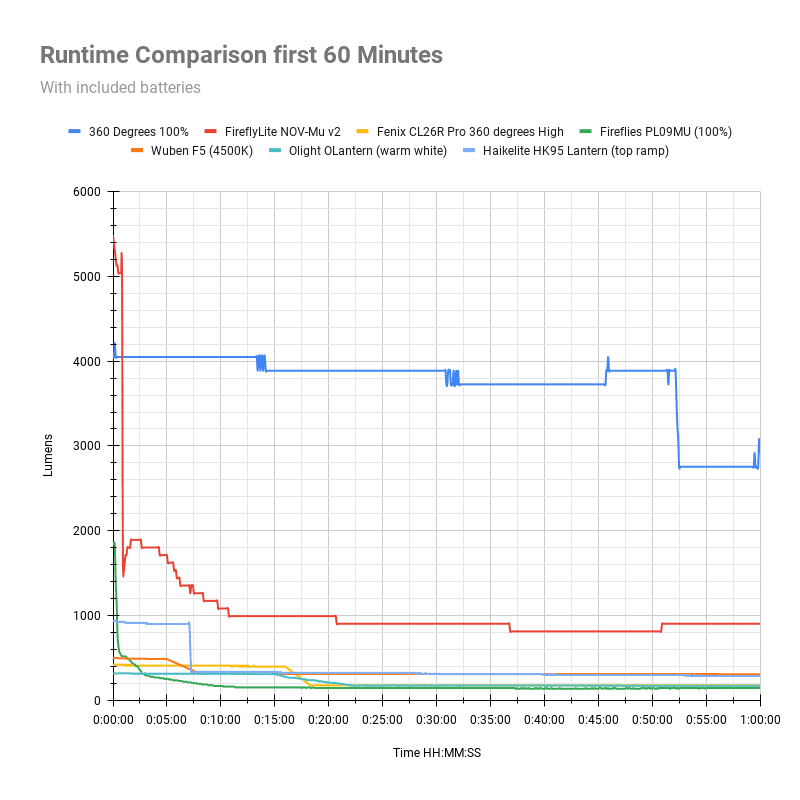
Peak beam intensity and beam distance measurements
About Peak beam intensity: Understanding ANSI FL1 Standards About peak beam intensity The calculated value of distance in meters at which the flashlight produces a light intensity of 0.25 lux. (0.25 lux is about the brightness of a full moon shining on an object). This means that the intensity has decreased so much, it becomes difficult to see darker objects, or objects that don’t reflect light. The columns ‘Meters’ and ‘Yards’ use rounded numbers.Beam distances are measured using a Uni-T UT383S luxmeter measured indoors at 5 meters using a fully charged internal battery. Measurements taken at 30 seconds.
| Mode | Specified | Candela measured | Meters | Yards |
|---|---|---|---|---|
| 360° Min | ? | 75 cd | 17 | 19 |
| 360° Max | ? | 1475 cd | 77 | 84 |
| 180° Min | ? | 150 cd | 24 | 26 |
| 180° Max | ? | 1200 cd | 69 | 75 |
| Front Min | ? | 1450 cd | 76 | 83 |
| Front Max | ? | 3550 cd | 116 | 127 |
Ambient temperature:
- 20 °C
The throw figures look pretty good for a lantern. I’ve never measured the Coleman 288 liquid fuel lantern I’ve used for years on camping trips, but I’d imagine it throws quite a bit farther! The top lighting mode has 100 meters of throw, which is good for large-area illumination
Beamshots
Camera settings and distance: Photos taken with a Canon EOS R100 with Canon RF-S 18-45 mm STM lens. For the outdoor shots on my patio and indoors, the camera is set to 1/60s, F4.5 ISO1600 and 5000K WB. For the indoor shots, the fireplace is about 5 meters away.
Beamshots of the following flashlights compared
Outdoors:
- Volterrex LED Lantern (360° at 100% output)
- FireflyLite NOV-Mu v2 Turbo mode with diffuser
- Fenix CL26R Pro (360° mode 100% output)
- Fireflies PL09 Mu Turbo mode with diffuser
- Coleman 288 maximum output
- Olight O Lantern Classic Pro 2 Warm White 100%
Indoors
- Volterrex LED Lantern (180° and Top Light)
- Wuben F5 (High mode 5700K)
- Olight Swivel Pro high mode
Please note that the following beamshots are mainly intended to showcase the beam pattern and beam quality, rather than overall performance. These images are typically taken directly after activation, and in different seasons or weather conditions, and therefore do not fully represent its overall performance. For accurate performance metrics, such as output, beam distance, and runtimes, you need to look at the performance section of this review.
The Haikelite HK95 and FireflyLite NovMu below are shot with different camera settings, so please don’t focus too much on the output in these pictures.. for comparing output, you have to compare the performance section of each lantern/flashlight’s review.










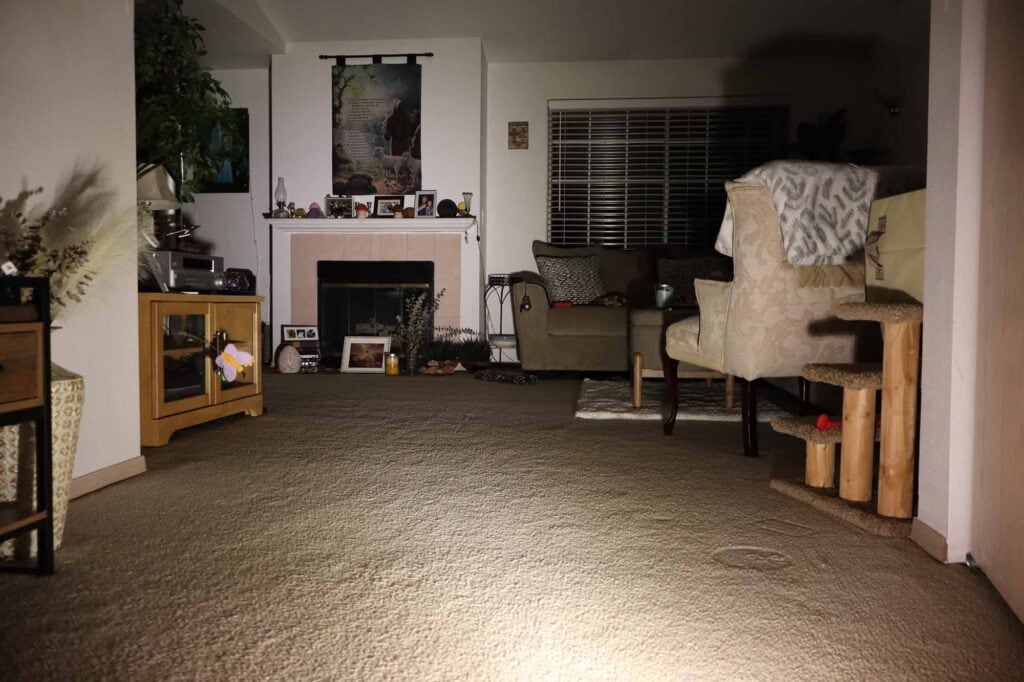





Disclaimer: This flashlight was sent to us for review at no cost by Volterrex. We have not been paid to review, nor have we been holding back on problems or defects.
Final Verdict
Pros
- Heavy duty with great build quality
- Lots of mounting options
- Great sustained output
- Power bank
- Nice CCT and CRI
- Infinitely adjustable output with simple UI
Cons
- Heatsink gets really hot
- Charging could be faster
- Threaded insert isn’t compatible with standard ¼-20 attachments
Explanation on star ratings:
1: Avoid: a match would be a better choice – 2: Poor: significant defect or issues; almost unusable – 3: Average: some defects or issues; but still usable 4: Good: recommended (minor issues) – 5: Great: highly recommended

5 stars: ★★★★★
While our star rating provides a reliable indicator, we encourage you to read the full review to make an informed decision based on your own needs and preferences.
While there’s tons of LED lanterns to choose from now, the majority are consumer-grade options for car camping, backpacking or at the high end, basecamp-type lanterns with high output, but low portability and short runtimes (and big price tags).
This Volterrex LED Lantern changes the game in that respect. What Volterrex has created is a pro-grade working-class LED lantern that’s going to be just as at home on the jobsite as the campsite (or wherever you need a lantern). Here’s what I like. It’s very well made and sturdy and should hold up to some rough and tumble use. It’s also really bright and has excellent sustained output with long runtimes.
The infinitely variable brightness and useful lighting modes were also pluses that added a lot of versatility, and I’m glad they gave it somewhat-high CRI and a nice CCT to boot. The beam pattern/light diffusion is about perfect as well. There’s lots of mounting options as well: hang it upright, upside down, or put it on a mast/tripod.
The power bank is an added bonus, and I actually like that they went with the trusty barrel jack input for charging. Misses with the Volterrex weren’t deal-breakers by any means and really just me being nit picky. The heatsink gets crazy hot if you use the 360 mode for more than 30 minutes (but doesn’t affect output and it’s isolated and the rest of the housing is warm/cool to the touch).
The charging, while not super slow, could be turned up a bit, and the threaded mount on the base won’t work with standard ¼-20 accessories.mounts, but again, neither here nor there.
So, should you go out and pick up a Volterrex LED Pro Lantern? Definitely! If you’ve got the cash to drop on one, I highly recommend it. This is a super-versatile lighting tool, and would be a great addition to any jobsite or campsite. If it weren’t for nostalgia and fond memories of camping trips past, I’d probably retire my Coleman 288 because this Volterrex LED Lantern is a huge upgrade. 5 stars.
Buy your Volterrex LED Pro Lantern here
Use the following code for 10% off at Volterrex, and get free shipping. Add code: 1lumen to your checkout.
1lumen selects and reviews products personally. We may earn affiliate commissions through our links, which help support our testing.